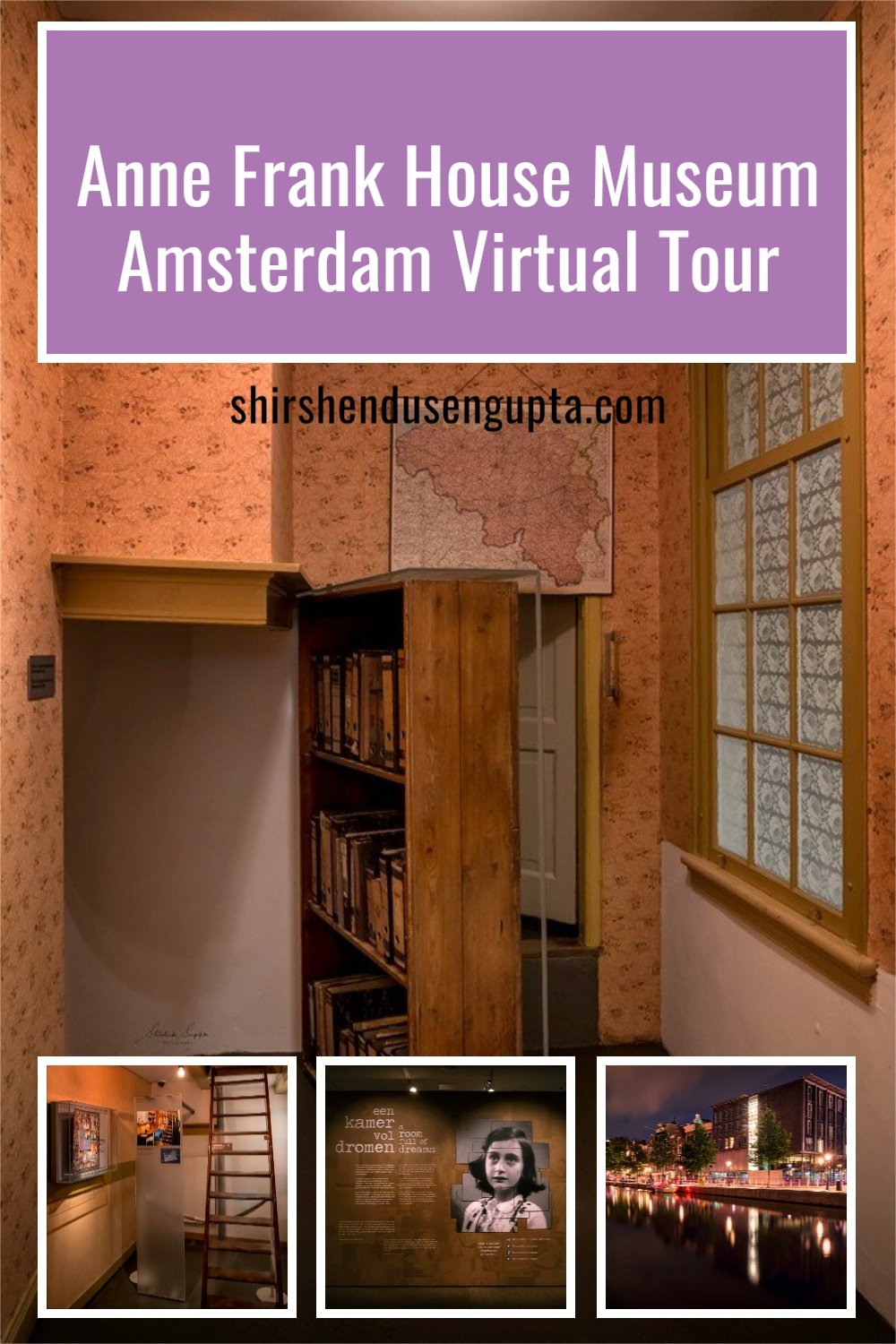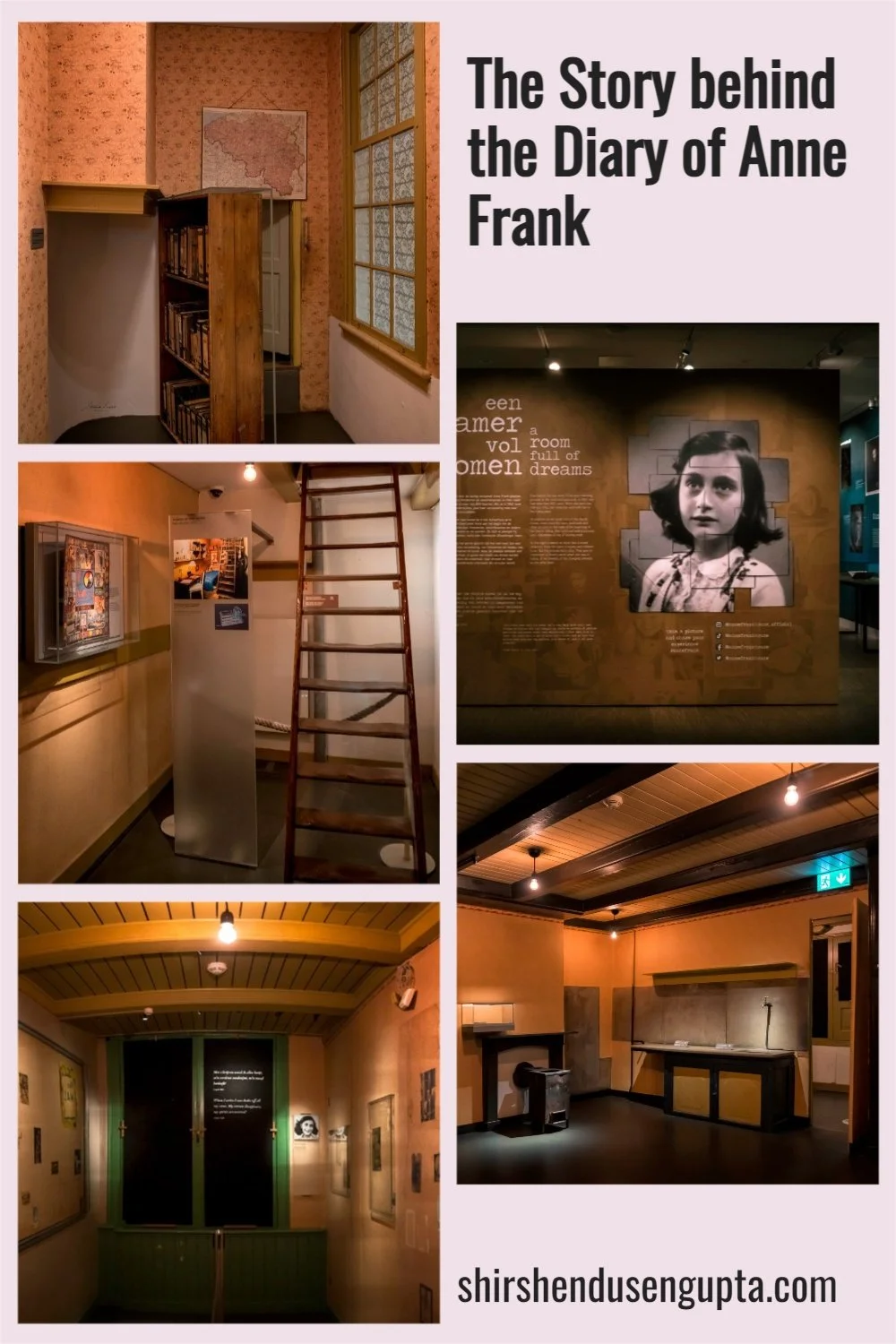Anne Frank House Museum Amsterdam Virtual Tour | The Story behind the Diary of Anne Frank
Who is Anne Frank?
Anne Frank was a German-born teenage Jewish girl whose diary of her family’s two years of hiding (1942 to 1944) in Amsterdam to avoid persecution by the Nazis during the Second World War, became a piece of classic war literature. She was later discovered by the Nazis and deported to the concentration camp at Bergen-Belsen in 1945, where she finally passed away.
What is The Diary of Anne Frank?
‘The Diary of a Young Girl,’ popularly known as ‘The Diary of Anne Frank,’ is one of the most well-known books of the twentieth century, that has inspired countless plays and films. Written between 1942 and 1944, it paints a vivid picture of a maturing young woman rising to the challenge when thrust into an incredible situation, and exposes the plight of individuals who suffered at the hands of the Nazis during their occupation of the Netherlands. As she and her family fled from the Nazis who wanted to kill her and her Jewish counterparts, Anne wrote about her feelings of wrath, love, puberty, dreams, and dread. Anne and her fellow prisoners were emotionally drained by the cramped rooms, little food, and inability to go outside. This resulted in tensions that mirrored the raging violence outside their hiding location. Anne's diary was saved by her friend Miep Gies and shared with her father, Otto Frank, for publication after the war.
What is Anne Frank House Museum?
The Anne Frank House, located in Amsterdam, was where she and her family hid from the Nazis for more than two years during World War II. It has been transformed into a museum and now houses a display about the Holocaust's persecution of Jews. Today, I’m going to take you along with me on a virtual tour through the Anne Frank House Museum.
The Story of Anne Frank and a Virtual Tour of Anne Frank House
The Early Life of Anne Frank
Anne Frank was born on June 12, 1929, in Frankfurt, Germany, at a time when Adolf Hitler and his party were gaining popularity in Germany. Hitler took advantage of the widespread anti-Semitism in Germany and blamed the Jews for the unemployment and poverty in the country. Anne's parents, Otto and Edith Frank decided to move to Amsterdam with Anne and Margot, her three years older sister, to avoid the anti-Jewish sentiment and a difficult economic condition in Germany. Otto established a business there that dealt in pectin, a gelling ingredient used in jam manufacturing.
Germany’s invasion of the Netherlands
Anne was a brilliant and inquisitive student at Amsterdam's Sixth Montessori School, where she had numerous friends from diverse origins and faiths. Her father put in a lot of effort to get his company off the ground in the Netherlands and also in England, but his plans kept failing until he began selling herbs and spices in addition to pectin. Germany invaded Poland on September 1, 1939, when Anne was ten years old, and the Second World War began. Soon after that, the Nazis invaded the Netherlands on May 10, 1940, and within five days, the Netherlands surrendered.
Anne gets the Diary as Birthday Gift
On Anne's 13th birthday, June 12, 1942, Otto presented her a red-and-white-checked notebook that she had chosen from a nearby shop. Anne chose to maintain her diary entries in it. "I hope I will be able to confide in you as I have never been able to confide in anyone, and I hope you will be a great source of comfort and support," she writes in her first entry.
Going into Hiding in the ‘Secret Annex’
The Nazis required the Jews to wear the Star of David on their clothing and prohibited them from holding companies. Otto Frank sold his company to Christian associates but continued to run it behind the scenes. Anne and Margot were forced to attend a Jewish school that was segregated. In 1942, Germans began deporting Dutch Jews to detention camps. The Franks attempted to immigrate to the United States but were denied visas. The family began making preparations to go into hiding. Otto Frank began preparing a hiding spot in the annex of his business premises.
On July 5, 1942, Margot received a summons to a so-called "labor camp." The family didn't think the call-up was for work, so they decided to go into hiding the next day to avoid being persecuted. A week later, the Van Pels family, who worked for Otto’s company, joined the Franks in the "Secret Annex," as the two families dubbed it. They were joined by an eighth person Fritz Pfeffer, a Frank family acquaintance, four months later. The hiding spot became jam-packed with eight people living in it. Anne had to stay very quiet and was frequently terrified. Because the warehouse was located below the hiding area and the warehouse personnel were ignorant of the people in hiding, any disturbance from the people in hiding was perilous.
A Virtual Tour of the ‘Secret Annex’
Landing with the Bookcase
The Frank family lived on the second and third floors, while the ground and the first floor continued to be used as the business premises. To reach the hiding location, one had to climb the staircase that connected the first and second floors to reach the landing, where stood a revolving bookcase behind which was the Secret Annex's door. Once you enter through the door, you step into a small corridor from where the Frank family's room is to the left, the bathroom is to the right, and the room of Mr. and Mrs. Van Pels is up the stairs.
Room of Anne Frank and Fritz Pfeffer
Anne, a fiery adolescent, shared a room with Fritz Pfeffer, a person of her father's age. This was unpleasant for both Anne and Fritz, and Anne vented her frustrations in her diary on many occasions.
Bathroom
The bathroom consisted of just a sink and a toilet, and the eight persons had their fixed time slots to use it. Anne’s time slot was every evening between 21:00 and 21:30.
Hermann and Auguste van Pels's room
The folks in hiding cooked and ate together in this room, and they listened to the radio there as well. The room was transformed into Mr. and Mrs. Van Pels' bedroom at night.
Room of Peter van Pels
Anne disliked Peter van Pels and his parents when they initially arrived at the Secret Annex. But, over time, they formed a friendship and even fell in love. In this room, Anne had her first kiss. The Secret Annex's attic is reached via the staircase.
The ‘Secret Annex’ Sold
The Pieron family, who were the legal owners of the building, had no idea that people were hiding in the Secret Annex. In 1943, the family sold the property for 14,000 guilders to a new owner. Anne was worried that the takeover might lead to the people in hiding being discovered. However, the new owner never visited the house.
Anne writes the Diary
Anne aspired to be a professional journalist. Throughout her tenure at the Secret Annex, Anne kept meticulous records. She also wrote a lot about her own feelings, thoughts, relationships, and personal experiences. The Jewish Women's Archive's program manager, Larisa Klebe, mentions, "For a 13-year-old girl, she was extremely thoughtful, intelligent and well-spoken. She writes about her complicated relationship with her mother, her body going through changes as she hits puberty in hiding, her feelings for Peter, her crush, etc."
The Nazis discover the ‘Secret Annex’
German police raided the Secret Annex on August 4, 1944. Everyone who was hiding was apprehended. 77 years later, in January 2022, a team made up of historians, ex-FBI agents, and other experts used modern investigative techniques to identify Arnold van den Bergh, a member of Amsterdam's Jewish Council, a body forced to implement Nazi policy in Jewish areas, as the betrayer who most likely tipped the Nazis about the Franks to save his own family.
Deportation and Death
The residents of the Secret Annex were initially taken to the Westerbork transit camp and later deported to Auschwitz on September 3, 1944, crammed in a cattle wagon for three days, with over a thousand other passengers. Men and women were separated there. This was the last time Anne saw her father. Around 350 persons from Anne's shipment were executed right away in the gas chambers.
Anne, Margot, and Edith worked hard together until November 1, 1944, when Margot and Anne were sent to Bergen-Belsen, Germany, while their parents were forced to remain in Auschwitz. Infectious illnesses were rife at Bergen-Belsen due to overcrowding. Anne and Margot contracted typhus after three months. In February 1945, Margot passed away. Anne passed away just a few days afterward.
Otto, Anne's father, was the only member of the Secret Annex to survive the war. The Russians rescued him from Auschwitz, and he learnt of his wife Edith's death during his long trek back to the Netherlands. He learned that Anne and Margot were also no longer living once he arrived in the Netherlands.
Anne’s diary gets famous
After the arrest of the Franks, Anne’s friend Miep Gies had discovered Anne's diary and kept it safely. Gies gave the diary to Otto, who had returned to Amsterdam, after learning of Anne’s death. Otto read Anne Frank's diary and said that it was “a revelation. There, was revealed a completely different Anne to the child that I had lost. I had no idea of the depths of her thoughts and feelings.” Otto was persuaded by friends to publish the diary, and 3,000 copies of Het Achterhuis (The Secret Annex), the original name of the book, were printed in June 1947. Today, renamed as ‘The Diary of a Young Girl’ or ‘The Diary of Anne Frank,’ it has been translated into 70 languages and adapted for the screen and theatre innumerable times.
Anne Frank House is opened to the Public
The Anne Frank House was in danger of being demolished after the liberation of the Netherlands from the Germans, but when Anne's account about life in the Secret Annex spread, opposition to the demolition plans grew. And it worked: demolition was averted in the mid-1950s, and the Anne Frank House Foundation was created shortly after, which repaired and opened the house to the public on May 3, 1960.
Visiting the Anne Frank House Museum
Address: The Anne Frank House is located at Prinsengracht 263-267, 1016 GV Amsterdam. The museum's entrance is just around the corner, at Westermarkt 20, 1016 GV Amsterdam.
Public Transport: The Anne Frank House is a 20-minute walk away from Amsterdam Centraal Railway Station. Alternatively, you can take tram 13 or 17 from Amsterdam Centraal towards Osdorp Dijkgraafplein and get down at Westermarkt and walk to the building.
Car Parking: No parking on site. You need to search for street parking which can be very challenging in Amsterdam. So it is better to arrive by public transport or leave the car at a parking garage nearby and walk to the building.
Opening Hours and Tickets: For information on the opening hours and for booking tickets in advance, please visit their official website annefrank.org/en. And to book last-minute tickets/packages for visiting Anne Frank House, click here.
Epilogue
So that was the story behind the ‘Diary of Anne Frank’. Please let us know in the comments below if you liked this article. And until we meet next time, I wish you merry traveling and happy shooting!
Pin the article
Bookmark the article for reading later!
Want to license/buy photos in the article?
License photos for commercial/editorial use or buy photo prints!
Want us to write an article for you?
Articles for magazines, newspapers, and websites!
Watch our Videos
Check out our videos on our Youtube Channel!
Join the Newsletter
Get updates on our latest articles!
We respect your privacy. Read our policy here.































